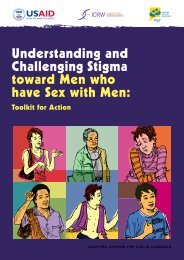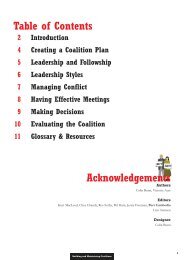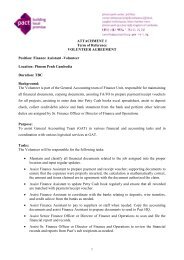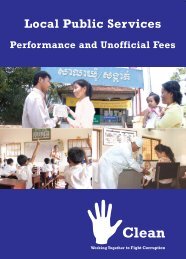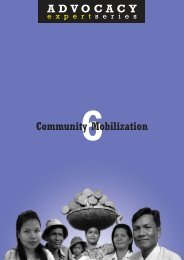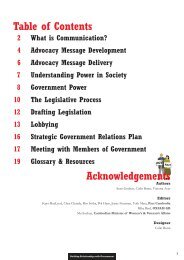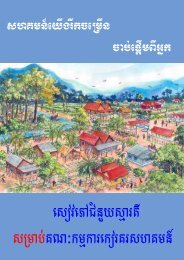Advocacy in Cambodia: Increasing Democratic ... - Pact Cambodia
Advocacy in Cambodia: Increasing Democratic ... - Pact Cambodia
Advocacy in Cambodia: Increasing Democratic ... - Pact Cambodia
You also want an ePaper? Increase the reach of your titles
YUMPU automatically turns print PDFs into web optimized ePapers that Google loves.
Case Studies<br />
EMO members did not feel that it would be useful<br />
to advocate this position as they felt women should<br />
be better educated first. Eventually however, the<br />
EMOs agreed to advocate for the NEC to adopt a<br />
policy encourag<strong>in</strong>g political parties to promote<br />
party lists comprised of 30% women candidates.<br />
Some women’s groups felt they could work directly<br />
with the parties to promote this objective.<br />
The EMOs spent considerable time and effort<br />
advocat<strong>in</strong>g for the proposed changes <strong>in</strong> the draft<br />
CCEL by us<strong>in</strong>g the strategies described below. The<br />
law was f<strong>in</strong>ally passed <strong>in</strong> March 2001, but none of<br />
the proposed changes were <strong>in</strong>corporated. The only<br />
change that was <strong>in</strong>corporated was the backup<br />
position regard<strong>in</strong>g the composition of the NEC.<br />
NGO Coord<strong>in</strong>at<strong>in</strong>g Committee (NGOCC)<br />
When the CCEL draft came out, NGOs were<br />
concerned about a provision to establish an NGO<br />
Coord<strong>in</strong>at<strong>in</strong>g Committee (NGOCC) to coord<strong>in</strong>ate<br />
NGO observers and provide election education. No<br />
consultation had taken place with NGOs regard<strong>in</strong>g<br />
this provision <strong>in</strong> the draft. The government<br />
proposed that the NGOCC be comprised of<br />
representatives from EMOs, human rights groups,<br />
and other social justice NGOs listed by the<br />
M<strong>in</strong>istry of Interior. The NEC would ultimately<br />
approve the NGOCC’s activities and have the<br />
power to dissolve it.<br />
EMOs feared that the Commune Council<br />
Election Law had been written <strong>in</strong> a way calculated<br />
to underm<strong>in</strong>e the <strong>in</strong>dependence of EMOs, by<br />
giv<strong>in</strong>g the NGOCC the ability to monitor NGO<br />
f<strong>in</strong>ances and control the NGO election statement.<br />
EMOs decided to lobby for a reduction <strong>in</strong> the<br />
NGOCC’s power and subsequently met with a<br />
number of legislators and government officials to<br />
expla<strong>in</strong> their views. The M<strong>in</strong>istry of Interior<br />
countered that the NGOCC was simply a<br />
mechanism to ensure that every poll<strong>in</strong>g station<br />
had an observer, but it did eventually agree to<br />
review articles concern<strong>in</strong>g the new agency’s<br />
formation.<br />
As late as March 2001, EMOs were still<br />
lobby<strong>in</strong>g aga<strong>in</strong>st the NGOCC but <strong>in</strong> the end the<br />
government ma<strong>in</strong>ta<strong>in</strong>ed its orig<strong>in</strong>al provisions. It<br />
was this issue that caused EMOs to consider<br />
withdraw<strong>in</strong>g from the election process.<br />
Intermediaries and legal advisors argued that<br />
articles describ<strong>in</strong>g the NGOCC’s role could be<br />
<strong>in</strong>terpreted <strong>in</strong> a number of ways, and a liberal<br />
<strong>in</strong>terpretation would be acceptable. Donors<br />
understood the EMOs’ concerns, but felt that their<br />
threat to withdraw from the election process was<br />
unreasonable, as no action that compromised the<br />
EMOs’ <strong>in</strong>tegrity had actually occurred. The<br />
impasse was eventually surmounted through<br />
dialogue between the EMOs and the NEC<br />
Secretary General, first at COPCEL meet<strong>in</strong>gs, and<br />
then <strong>in</strong> follow-up meet<strong>in</strong>gs. In the discussions<br />
EMOs learned that NEC technical staff agreed with<br />
the EMOs’ <strong>in</strong>terpretation of the articles, and this<br />
put the EMOs more at ease.<br />
Unfortunately, the Secretary General’s<br />
<strong>in</strong>terpretation of the statute was different from the<br />
NEC’s, and EMOs cont<strong>in</strong>ued to perceive the<br />
NGOCC as an obstruction to their work. The<br />
NGOCC limited the EMOs’ direct access to the<br />
NEC, and tried to control the EMOs by sett<strong>in</strong>g<br />
conditions for the issuance of official NEC<br />
accreditation cards. For example, the NGOCC<br />
claimed that EMO requests for accreditation cards<br />
were made too early and that EMOs did not<br />
provide enough <strong>in</strong>formation. EMOs were not<br />
advised what additional <strong>in</strong>formation was needed<br />
however, and even after provid<strong>in</strong>g complete<br />
<strong>in</strong>formation some applications were still rejected.<br />
After study<strong>in</strong>g the law, COMFREL <strong>in</strong>formed<br />
the NGOCC that it had no right to reject requests,<br />
but rather could only <strong>in</strong>dicate if requests were<br />
satisfactory or not. Requests could only be denied<br />
by the NEC. Ultimately, EMOs simply bypassed<br />
the NGOCC, submitt<strong>in</strong>g their requests directly to<br />
the NEC, which did not risk reject<strong>in</strong>g EMO<br />
requests due to concerns about negative donor<br />
reactions.<br />
<strong>Advocacy</strong> Strategies<br />
Board members of election monitor<strong>in</strong>g<br />
coalition groups are for the most part committed<br />
staff of other human rights and governance<br />
organizations. EMO staff tends to be particularly<br />
experienced <strong>in</strong> the area of human rights. It comes<br />
as little surprise then that EMOs, even those<br />
organizations that are relatively young, are strong.<br />
A solid tradition of advocacy enables them to use<br />
a range of strategies to reach their objectives.<br />
Sett<strong>in</strong>g Objectives & Distribution of Tasks<br />
When the CCEL campaign was first<br />
envisioned, EMOs had at least 20 issues that they<br />
wanted to advocate. A critical part of their<br />
advocacy process was narrow<strong>in</strong>g down their<br />
objectives so that they could focus their energy on<br />
a few top priorities. Thus, out of 20 or so <strong>in</strong>itial<br />
objectives, only three objectives were reta<strong>in</strong>ed.<br />
Another step <strong>in</strong> their advocacy process was<br />
assign<strong>in</strong>g tasks to each organization accord<strong>in</strong>g to<br />
its capacity and availability. Examples <strong>in</strong>clude<br />
assign<strong>in</strong>g <strong>in</strong>dividuals to lobby<strong>in</strong>g delegations,<br />
establish<strong>in</strong>g a system for send<strong>in</strong>g emails, and<br />
assign<strong>in</strong>g groups to study<strong>in</strong>g articles <strong>in</strong> the draft<br />
law. While delegat<strong>in</strong>g tasks seems like a very basic<br />
strategy, the process of do<strong>in</strong>g so provided a good<br />
way of identify<strong>in</strong>g resources and comparative<br />
strengths between advocat<strong>in</strong>g groups <strong>in</strong> order to<br />
68




